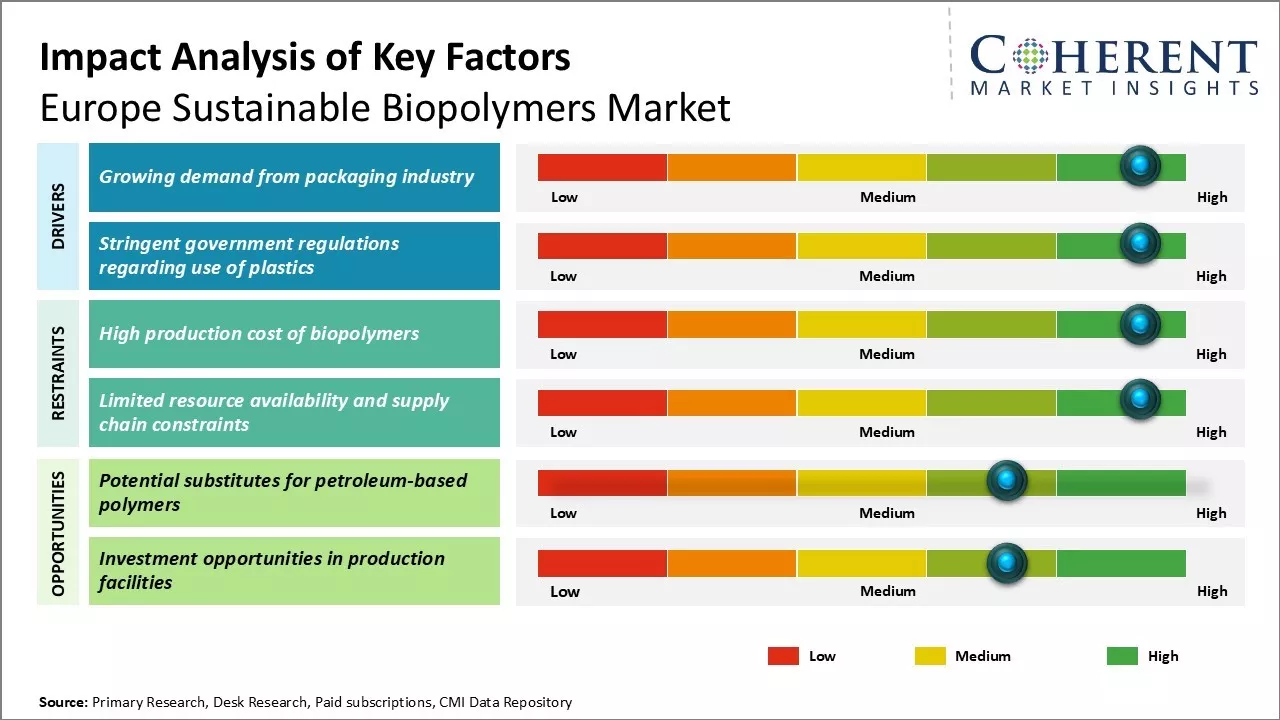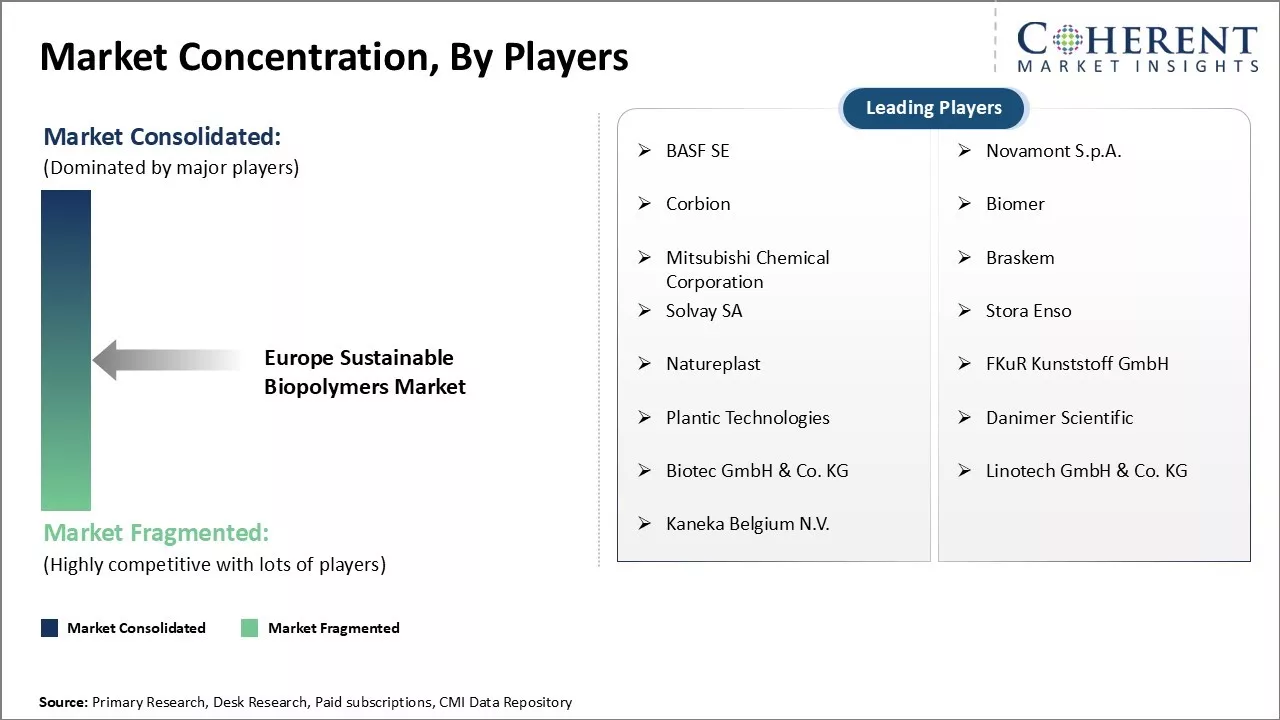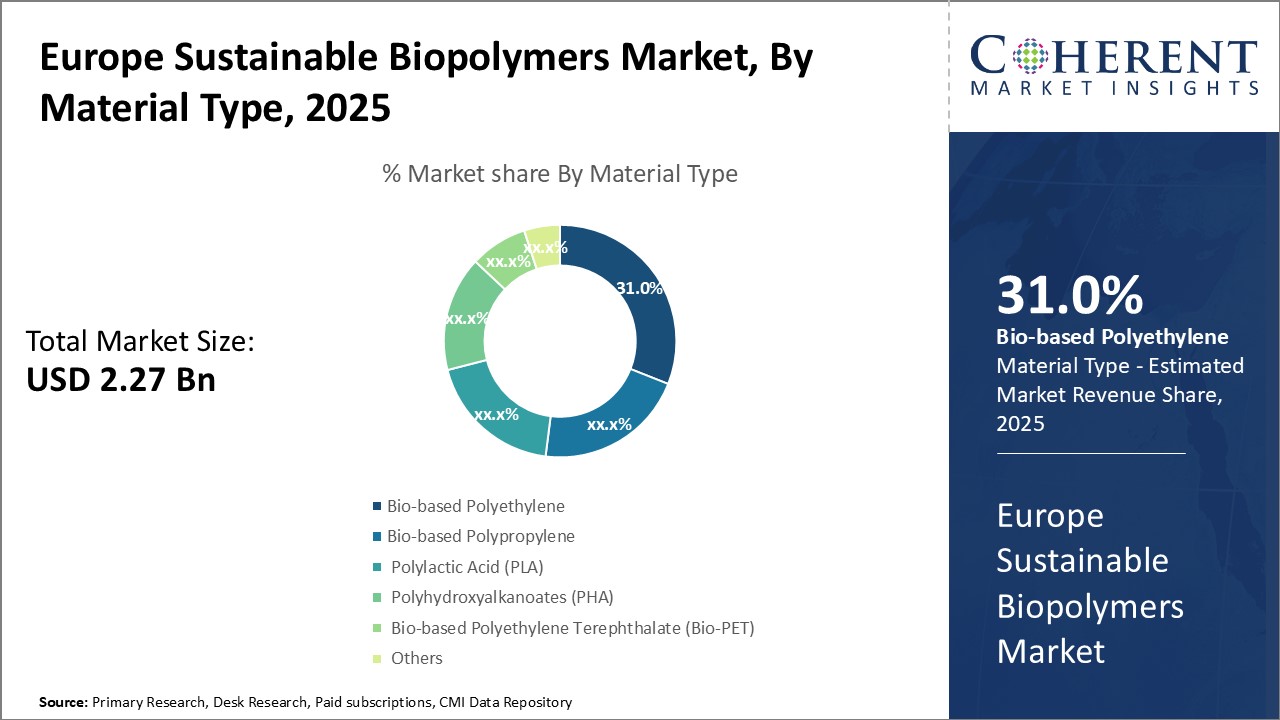Europe Sustainable Biopolymers Market Size and Trends
The Europe sustainable biopolymers market is estimated to be valued at USD 2.27 Bn in 2025 and is expected to reach USD 3.98 Bn by 2032, exhibiting a compound annual growth rate (CAGR) of 8.3% from 2025 to 2032.

Discover market dynamics shaping the industry: Download Free Sample
Stringent government regulations regarding the use of conventional plastics along with the growing environmental consciousness among consumers and industries are expected to drive the adoption of sustainable biopolymers in the region.
Growing demand from packaging industry
The packaging industry in Europe has been showing significant growth over the past few years predominantly driven by the increased demands for flexible as well as sustainable packaging solutions. Traditional plastic packaging materials have come under scrutiny due to environmental concerns around non-biodegradability. This has prompted packaging manufacturers to look for more eco-friendly alternatives. Biopolymers offer a viable solution as they can be completely biodegradable and break down fairly quickly in compost or anaerobic digestion facilities.
Materials like bio-PET, PLA, Bio-PE, and others have gained traction in the packaging industry. Various FMCG companies have been actively partnering with packaging providers to come up with sustainable options made from biopolymers. For instance, a leading consumer goods giant has collaborated with a flexible packaging producer to develop Stand Up Pouches made from PLA for their coffee product range. Similarly, a global snack foods brand switched to using bio-PE-based laminates for its snack packs owing to its renewable content. Increasing commitments by leading brands towards sustainability has put pressure on the entire packaging supply chain to transition towards greener options.
Produce packaging is another area where biopolymers such as bio-PET and PLA films find widespread usage. They help extend the shelf-life of fruits and vegetables while ensuring they are compostable at the end-of-life. Many supermarket chains in the region now offer biodegradable produce bags made from such materials. Even quick service restaurants are seeking biopolymer-based clear clamshell containers and cups as contingencies for single-use plastic bans. The convenience offered by the mechanical properties and processing abilities of biopolymers makes them an attractive value proposition for a wide range of rigid as well as flexible consumer packaging applications.
With environmental stewardship gaining prominence amongst brand owners and retail buyers, packaging manufacturers will have to increasingly rely on sustainable resins like biopolymers. This growing demand is anticipated to drive higher production volumes for companies involved in the manufacturing of biopolymer resins and compounds. It will also open up opportunities for equipment providers and machinery OEMs who can tailor their solutions for processing renewable biopolymers efficiently. While biopolymers still account for a modest share of the overall plastic packaging demand, their uptake is expected to accelerate in the coming years on account of favorable market trends as well as policy impetus.
Market Concentration and Competitive Landscape

Get actionable strategies to beat competition: Download Free Sample
Stringent Government Regulations Regarding Use of Plastics
The issue of plastic pollution is being witnessed in almost every European country owing to the ubiquitous usage of single-use plastic items and packaging materials that are difficult to recycle. Non-biodegradable plastics clog landfills and waterways, posing threats to biodiversity as well as human health. They also conflict with the principles of circular economy promoted within the European Union. As a result, governments across the region have been actively formulating laws and directives to curb plastic waste generation and establish an effective waste management infrastructure.
Several nations have introduced bans on specific problematic plastics like grocery bags, cutlery, straws, and Styrofoam containers. Thresholds have been set for minimum recycled content percentages in plastic packaging to spur greater plastic reprocessing abilities. Extended Producer Responsibility measures make plastic manufacturers responsible for end-of-life management of their products. More countries are moving towards the model of "Pay As You Throw" where households and businesses are charged per unit of non-recyclable trash sent to landfills or incinerators. The overarching aim is to make plastic packaging producers finance waste collection as well as establish take-back systems.
Besides plastic items, single-use packaging has also come under regulatory scanner. The European Commission has proposed new rules establishing minimum recycled content standards for beverage bottles.
Key Takeaways from Analyst:
Regulatory push towards limiting single-use plastics along with increasing consumer awareness about environment protection will be the major drivers of this market. Stringent rules mandating the minimum usage of bioplastics in packaging applications is expected to open new avenues for biopolymer manufacturers. Moreover, favorable government policies in the form of tax incentives and subsidies on R&D of biodegradable polymers will encourage innovation.
Growing emphasis on sustainable alternatives to petroleum-based polymers across industries like packaging, textile and automotive in countries like the U.K., France, Italy, and Spain will boost material adoption. On the other hand, high price point of biopolymers as compared to conventional plastics may restrict widespread consumption until costs fall. Lack of standardized regulations regarding the labeling of biodegradability may also limit full potential.
Opportunities lie in collaborations between brand owners, biopolymer companies, and technology providers to develop novel application-specific solutions that provide competitive pricing without compromising on performance. Integration with waste management infrastructure needs scaling up to realize complete degradability.
Market Challenges: High production cost of biopolymers
One of the major challenges faced by the Europe sustainable biopolymers market is the high production cost of biopolymers as compared to traditional petroleum-based polymers. Producing biopolymers requires the use of renewable biomass such as cornstarch, sugarcane, or microorganisms, which makes the production process capital intensive. The cultivation of these biomass feedstocks as well as their processing into biopolymers demands significant capital expenditure and operational expenses. This results in biopolymers having a higher price tag compared to counterparts derived from fossil fuels. Production technologies are also currently not mature enough to yield economies of scale. Additionally, fluctuations in agricultural commodity prices directly impact the prices of biopolymers. These cost disadvantages have restricted the mass adoption of biopolymers in Europe, particularly in price-sensitive applications. For the market to experience sustainable growth, reducing manufacturing costs through technological advancements and achieving cost parity with traditional plastics remains a major task.
Market Opportunities: Potential Substitutes for Petroleum-based Polymers
The growing awareness and regulations around sustainability provide a big opportunity for biopolymers to be used as potential substitutes for petroleum-based polymers in Europe. Traditionally, plastics have been derived from non-renewable fossil fuel resources. However, the limited reserves and environmental impact of plastics have boosted the need to shift towards bio-based alternatives. Biopolymers offer comparable material properties to fossil fuel-based plastics and can serve as a ‘green’ substitute across various end-use industries like packaging, textiles, consumer goods, and automotive. As European regulations progressively ban single-use plastics and mandate higher use of recycled content, the market demand for biopolymers is expected to surge. If production technologies advance to offer cost-competitiveness, biopolymers have immense scope to displace a significant share of the plastic market in Europe and bolster the transition towards a circular economy.

Discover high revenue pocket segments and roadmap to it: Download Free Sample
Insights by material type: Rising Demand for Biodegradable Products
In terms of material type, bio-based polyethylene is expected to contribute 31.0% share of the sustainable biopolymers market in 2025, due to increasing demand for biodegradable and recyclable products from packaging and other industries. Polyethylene is widely used for packaging applications such as plastic bags, bottles and containers due to its mechanical properties and flexibility. Conventional polyethylene is derived from non-renewable fossil fuels and takes hundreds of years to degrade. However, bio-based polyethylene is produced from ethanol fermented from sugar cane, corn or other biomass feedstocks. It offers the benefits of biodegradability without compromising on the processability and durability of traditional polyethylene.
Insights by application: E-commerce boom and demand for convenient packaging solutions
The packaging industry has witnessed strong growth in Europe driven by the e-commerce boom and demand for convenient packaging solutions. The packaging segment is expected to hold 46.1% of the market share in 2025. However, traditional plastic packaging has become a major source of pollution due to the immense amount of plastic waste. This has prompted packaging manufacturers to incorporate more sustainable alternatives. Bio-based polyethylene provides packaging producers an eco-friendly option to replace fossil-fuel derived polyethylene without significant changes to existing manufacturing infrastructure or processes. It can degrade completely within few months when disposed under industrial composting conditions. This important property is boosting its preference among brand owners and consumers who are increasingly concerned about the environmental impact of plastics.
Stringent regulations regarding plastic waste recycling and bans on single-use plastics in Europe are another key factor driving the shift towards bio-based polyethylene. Many European countries have introduced packaging waste recycling targets and landfill bans for plastic packaging to promote circular economy principles. This regulatory push is compelling packaging manufacturers to seek out sustainable bioplastic solutions in order to remain compliant without compromising on performance. The favorable regulatory stance and growing consumer demand for green alternatives will continue propelling the Europe bio-based polyethylene market during the forecast period.
Market Report Scope
Europe Sustainable Biopolymers Market Report Coverage
| Report Coverage | Details | ||
|---|---|---|---|
| Base Year: | 2024 | Market Size in 2025: | USD 2.27 Bn |
| Historical Data for: | 2020 To 2024 | Forecast Period: | 2025 To 2032 |
| Forecast Period 2025 to 2032 CAGR: | 8.3% | 2032 Value Projection: | USD 3.98 Bn |
| Geographies covered: |
|
||
| Segments covered: |
|
||
| Companies covered: |
BASF SE, Novamont S.p.A., Corbion, Biomer, Mitsubishi Chemical Corporation, Braskem, Solvay SA, Stora Enso, Natureplast, FKuR Kunststoff GmbH, Plantic Technologies, Danimer Scientific, Biotec GmbH & Co. KG, Linotech GmbH & Co. KG, and Kaneka Belgium N.V. |
||
| Growth Drivers: |
|
||
| Restraints & Challenges: |
|
||
Uncover macros and micros vetted on 75+ parameters: Get instant access to report
Europe Sustainable Biopolymers Industry News
- In June 2024, BASF, a global leader in chemical production, announced the expansion of its biopolymers portfolio with the introduction of biomass-balanced ecoflex (PBAT). This innovative product represents a significant step forward in sustainable materials, offering an environment-friendly alternative for various applications.
*Definition: The Europe sustainable biopolymers market refers to the market for biopolymers that are produced from renewable biomass sources in a sustainable manner in the European countries. It comprises bioplastics made from plant-based materials like corn, sugarcane, or microbiological fermentation of sugar. These bioplastics offer environment-friendly alternatives to conventional plastics that are petroleum-based with better end-of-life characteristics like recyclability.
Market Segmentation
- By Material Type Insights (Revenue, USD Bn, 2020 - 2032)
-
- Bio-based Polyethylene
- Bio-based Polypropylene (Bio-PP)
- Polylactic Acid (PLA)
- Polyhydroxyalkanoates (PHA)
- Bio-based Polyethylene Terephthalate (Bio-PET)
- Others
- By Application Insights (Revenue, USD Bn, 2020 - 2032)
- Packaging
- Agriculture & Horticulture
- Textiles
- Automotive
- Electronics
- Others
- Key Players Insights
- BASF SE
- Novamont S.p.A.
- Corbion
- Biomer
- Mitsubishi Chemical Corporation
- Braskem
- Solvay SA
- Stora Enso
- Natureplast
- FKuR Kunststoff GmbH
- Plantic Technologies
- Danimer Scientific
- Biotec GmbH & Co. KG
- Linotech GmbH & Co. KG
- Kaneka Belgium N.V.
Share
Share
About Author
Yash Doshi is a Senior Management Consultant. He has 12+ years of experience in conducting research and handling consulting projects across verticals in APAC, EMEA, and the Americas.
He brings strong acumen in helping chemical companies navigate complex challenges and identify growth opportunities. He has deep expertise across the chemicals value chain, including commodity, specialty and fine chemicals, plastics and polymers, and petrochemicals. Yash is a sought-after speaker at industry conferences and contributes to various publications on topics related commodity, specialty and fine chemicals, plastics and polymers, and petrochemicals.
Missing comfort of reading report in your local language? Find your preferred language :
Transform your Strategy with Exclusive Trending Reports :
Frequently Asked Questions
EXISTING CLIENTELE
Joining thousands of companies around the world committed to making the Excellent Business Solutions.
View All Our Clients
